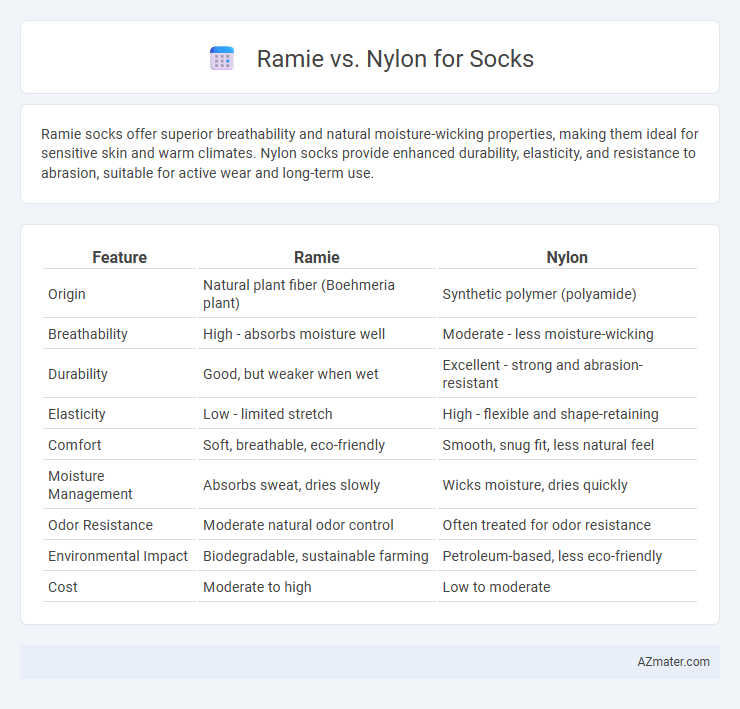Ramie socks offer superior breathability and natural moisture-wicking properties, making them ideal for sensitive skin and warm climates. Nylon socks provide enhanced durability, elasticity, and resistance to abrasion, suitable for active wear and long-term use.
Table of Comparison
| Feature | Ramie | Nylon |
|---|---|---|
| Origin | Natural plant fiber (Boehmeria plant) | Synthetic polymer (polyamide) |
| Breathability | High - absorbs moisture well | Moderate - less moisture-wicking |
| Durability | Good, but weaker when wet | Excellent - strong and abrasion-resistant |
| Elasticity | Low - limited stretch | High - flexible and shape-retaining |
| Comfort | Soft, breathable, eco-friendly | Smooth, snug fit, less natural feel |
| Moisture Management | Absorbs sweat, dries slowly | Wicks moisture, dries quickly |
| Odor Resistance | Moderate natural odor control | Often treated for odor resistance |
| Environmental Impact | Biodegradable, sustainable farming | Petroleum-based, less eco-friendly |
| Cost | Moderate to high | Low to moderate |
Introduction to Ramie and Nylon Socks
Ramie socks are crafted from a natural fiber derived from the stalks of the ramie plant, known for its breathability, moisture-wicking properties, and durability. Nylon socks, made from a synthetic polymer, offer excellent elasticity, strength, and resistance to abrasion, making them popular for athletic and everyday wear. When choosing between ramie and nylon socks, factors such as comfort, moisture management, and long-term durability play a crucial role in performance and user satisfaction.
Material Origins: What are Ramie and Nylon?
Ramie is a natural fiber derived from the stalks of the Boehmeria plant, known for its strength, breathability, and moisture-wicking properties. Nylon is a synthetic polymer fabric made from petrochemicals, prized for its elasticity, durability, and resistance to abrasion. These fundamental differences in material origins influence their performance characteristics in sock manufacturing.
Comfort and Feel: Ramie vs Nylon
Ramie offers a natural, breathable texture that feels cooler and softer against the skin, making it highly comfortable for socks in warm conditions. Nylon provides a smooth, stretchy feel with high durability but can retain heat and moisture, often resulting in less breathability compared to ramie. Choosing ramie enhances natural comfort and moisture-wicking, while nylon emphasizes resilience and a snug fit.
Durability and Longevity Comparison
Ramie fibers exhibit excellent durability due to their natural strength and resistance to wear, making ramie socks long-lasting and resilient against frequent washing. Nylon socks offer superior elasticity and abrasion resistance, enhancing their durability and maintaining shape over extended use. When comparing longevity, nylon typically outperforms ramie by retaining flexibility and structural integrity under heavy wear conditions.
Moisture Wicking and Breathability
Ramie fibers offer excellent moisture-wicking properties by absorbing water quickly and allowing it to evaporate, keeping feet dry and comfortable. Nylon, while durable and stretchy, tends to retain moisture and lacks the natural breathability of ramie. Socks made from ramie provide superior ventilation and moisture management compared to nylon, making them ideal for hot or active conditions.
Antimicrobial and Odor Control Properties
Ramie fibers naturally contain antimicrobial agents that inhibit bacterial growth, making them effective for odor control in socks. Nylon, a synthetic fiber, lacks inherent antimicrobial properties but can be treated with antimicrobial finishes to reduce odors. Ramie's breathable, moisture-wicking structure enhances odor resistance more sustainably compared to nylon's moisture-retentive nature.
Environmental Impact and Sustainability
Ramie fibers, derived from the flowering plant in the nettle family, are biodegradable and require fewer pesticides and less water compared to nylon, making them an eco-friendly choice for socks. Nylon, a synthetic polymer made from petrochemicals, contributes to microplastic pollution and has a higher carbon footprint due to its energy-intensive manufacturing process. Choosing ramie over nylon enhances sustainability by reducing environmental harm through renewable, natural fiber use and minimizing synthetic waste in textile production.
Care and Maintenance of Ramie vs Nylon Socks
Ramie socks require gentle hand washing with mild detergent to maintain their natural fibers and prevent shrinkage, while nylon socks are more durable and machine washable, allowing for easy care and quick drying. Ramie is prone to wrinkles and may lose shape if exposed to high heat, so air drying is essential, whereas nylon resists wrinkles and retains elasticity after repeated laundering. Proper care of ramie socks involves avoiding bleach and high temperatures, whereas nylon socks tolerate regular washing cycles and are less susceptible to damage from abrasive washing methods.
Price Comparison and Affordability
Ramie fiber socks generally cost more than nylon alternatives due to the natural, eco-friendly production process and lower supply compared to synthetic fibers. Nylon socks offer a more affordable price point, making them a popular choice for budget-conscious consumers seeking durability and elasticity. When prioritizing cost-effectiveness, nylon socks provide better value without compromising basic performance.
Which is Better for Socks: Ramie or Nylon?
Ramie excels in breathability and moisture-wicking, making it ideal for socks requiring natural fiber comfort and odor resistance. Nylon offers superior durability, elasticity, and abrasion resistance, ensuring longevity and a snug fit for active wear. For socks, nylon is generally better for high-performance needs, while ramie is preferred for natural, eco-friendly options with enhanced comfort.

Infographic: Ramie vs Nylon for Sock
 azmater.com
azmater.com